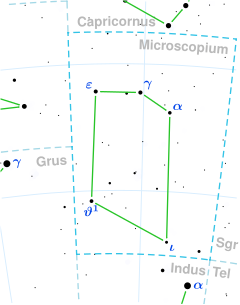 Global Information
Global InformationKappa1 Sagittarii information
 | |
| Observation data Epoch J2000.0 Equinox J2000.0 (ICRS) | |
|---|---|
| Constellation | Sagittarius |
| Right ascension | 20h 22m 27.50366s[1] |
| Declination | −42° 02′ 58.3648″[1] |
| Apparent magnitude (V) | +5.58[2] |
| Characteristics | |
| Spectral type | A0 V[3] |
| U−B color index | −0.008[2] |
| B−V color index | +0.004[2] |
| Astrometry | |
| Radial velocity (Rv) | −11.6[4] km/s |
| Proper motion (μ) | RA: +41.312[5] mas/yr Dec.: −83.742[5] mas/yr |
| Parallax (π) | 14.6086 ± 0.1738 mas[5] |
| Distance | 223 ± 3 ly (68.5 ± 0.8 pc) |
| Absolute magnitude (MV) | 1.47[6] |
| Details | |
| Mass | 2.23±0.02[7] M☉ |
| Radius | 1.7[8] R☉ |
| Luminosity | 27.5[7] L☉ |
| Surface gravity (log g) | 4.33[9] cgs |
| Temperature | 9,962±339[9] K |
| Rotational velocity (v sin i) | 79[3] km/s |
| Age | 161[9] Myr |
| Other designations | |
κ1 Sgr, CD−42°14836, HD 193571, HIP 100469, HR 7779, SAO 230177, WDS J20225-4203[10] | |
| Database references | |
| SIMBAD | data |
Kappa1 Sagittarii (κ1 Sagittarii) is a solitary,[11] white-hued star in the zodiac constellation of Sagittarius. It has an apparent visual magnitude of +5.58,[2] which is bright enough to be faintly visible to the naked eye. According to the Bortle scale, it can be viewed from dark suburban skies. Based upon an annual parallax shift of 15.12 mas as seen from Earth,[1] this star is located around 223 light years from the Sun. It is advancing in the general direction of the Sun with a radial velocity of −11.6 km/s.[4]
This is an A-type main sequence star with a stellar classification of A0 V.[3] It displays an infrared excess, with the measured radiation indicating the star is orbited by a two-component debris disk.[8] The star is about 161[9] million years old with 2.23[7] times the mass of the Sun and 1.7[8] times the Sun's radius. It is radiating 27.5 times the Sun's luminosity from its photosphere at an effective temperature of roughly 9,962 K.[9]
There are two visual companions: component B is a magnitude 12.6 star at an angular separation of 39.3 arc seconds along a position angle of 312°, as of 2000; component C is magnitude 11.6 with a separation of 56.8 arc seconds along a position angle of 283°, as of 1999.[12] Neither star is physically associated with Kappa1 Sagittarii.[11]
- ^ a b c Cite error: The named reference
vanLeeuwen2007was invoked but never defined (see the help page). - ^ a b c d Cite error: The named reference
Cousins1983was invoked but never defined (see the help page). - ^ a b c Cite error: The named reference
Royer2007was invoked but never defined (see the help page). - ^ a b Cite error: The named reference
Evans1966was invoked but never defined (see the help page). - ^ a b c Cite error: The named reference
dr2was invoked but never defined (see the help page). - ^ Cite error: The named reference
AmmlerVonEiff2012was invoked but never defined (see the help page). - ^ a b c Cite error: The named reference
Zorec2012was invoked but never defined (see the help page). - ^ a b c Cite error: The named reference
Patel2017was invoked but never defined (see the help page). - ^ a b c d e Cite error: The named reference
David2015was invoked but never defined (see the help page). - ^ Cite error: The named reference
SIMBADwas invoked but never defined (see the help page). - ^ a b Cite error: The named reference
Eggleton2008was invoked but never defined (see the help page). - ^ Cite error: The named reference
WDSC2014was invoked but never defined (see the help page).